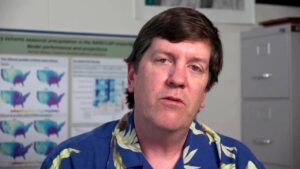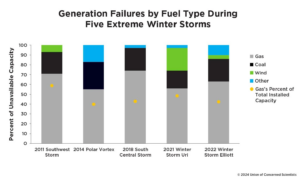Horrendous climate-driven storms are here. From Lawrence Berkeley National Laboratory, senior scientist Dr. Michael Wehner makes the case for Cat 6. Electricity from natural gas is more reliable than renewables, right? Wrong. Mark Specht from the Union of Concerned Scientists finds gas plant failures bring grids down. From the New Zealand Joseph Merz on the latest World scientists’ warning: The behavioral crisis driving ecological overshoot.
Listen to or download this Radio Ecoshock show in CD Quality (57 MB) or Lo-Fi (14 MB)
1.5 IS GONE, GONE, GONE
The European Union’s Copernicus project just announced Earth has been over 1.5 degrees C over-preindustrial for the last twelve months. We already reached the climate “safety barrier” predicted for the year 2030 or later. The top U.N. climate body released it “Special Report on global Warming of 1.5 ºC” in 2018. International climate conferences with tens of thousands of delegates were told 1.5 degrees C warming was the goal and still possible. No longer.
The U.N.’s IPCC already claim 1.5 only counts if it lasts not one year but a decade. We may dip lower next year if recent predictions of a switch back to the cooler La Nina ocean pattern develops later in 2024. Or we may keep climbing from 1.5.
Anyway the IPCC officials are counting on carbon capture and storage technology or geoengineering to bring temperatures back down below 1.5. Carbon capture is no where to be found and we have not even researched geoengineering in any meaningful way. Geoengineering is not like an experiment you can do in a lab. The planet is the lab and you can’t take it back if bad side effects develop, like monsoon failure over the crops feeding billions of people.
We have been sold shiny dreams while fossil fuel demand, production and emissions keep climbing to record levels. Shiny dreams from official sources could be the death of us. Farewell to 1.5 and onward to a burning future.
Let’s go to our first guest.
MICHAEL WEHNER
THE CASE FOR CAT 6 HURRICANES
Giant storms with floods and ocean surge are stronger in recent decades. Call them hurricanes, typhoons, or tropical cyclones – they carry winds so strong scientists want to add a new level. If Cat 5 or “super typhoon” is not enough – what is a Cat 6? Have they arrived?

Dr. Michael Wehner is a senior scientist at the Lawrence Berkeley National Laboratory. As a recognized expert, Wehner published over 250 peer-reviewed papers, many heat waves, extreme weather and tropical cyclones in a time of climate change. He is a Lead Author for Intergovernmental Panel on Climate Change reports and U.S. National Climate Assessments.
From San Francisco, we welcome back Michael Wehner.
Listen to or download this 22 minute interview with Michael Wehner in CD Quality or Lo-Fi
Wehner and James Kossin just published in PNAS: “The growing inadequacy of an open-ended Saffir–Simpson hurricane wind scale in a warming world.” The Saffir–Simpson hurricane wind scale is better known as the rating from Cat 1 to Cat 5 storms. There is no Cat 6 because the inventing scientists found Cat 5 winds strong enough to demolish almost anything, so why go higher? But now super storms are showing up.
The Saffir-Simpson scale known to North Americans and Europeans is not used in China. The Chinese have their own system reaching it’s highest level of Super Typhoon at 51.4 m/s; 115.0 mph or 185.0 km/h. That is below our Cat 3. Like the American system, the Chinese also appear to lack the language for climate-driven monster storms above 150 miles per hour or 70 meters per second wind speed. India uses their own different system, so does Australia. The Saffir-Simpson scale is used in the UK, e.g. by the UK Met Office.
Other planets have faster winds. On Neptune, methane clouds blow over 1200 miles per hour or 2,000 kilometers an hour. Speaking of Earth, Wehner’s paper says “record wind speeds will likely continue to be broken as the planet continues to warm.“ The current reliable world wind speed record is 253 miles per hour, 407 Kilometers per hour, at Barrow Island Australia.
IS THERE AN UPPER LIMIT TO WIND SPEEDS?
Is there an upper limit to wind speeds on Earth, and what in planetary physics sets that protective limit? There probably is and Michael explains that in our interview. (It builds on hurricanes as a Carnot Engine with limits in atmosphere dynamics…) The paper says: “...we note that stability issues might place a limit on the upper bound of highest achievable T[ropical] C[yclone] wind speeds that are not included in the formulation of PI. Nonetheless, the recent occurrence of the category 6 storms discussed in Section 1 suggests that this limit, if it exists, has not yet been reached.” “PI” is the Potential Intensity scale developed for tropical cyclones by Immanuel Kerry of MIT.
For example, find Max PI maps here.
The U.S. was hit by three Cat 5 storms in 2005: Katrina, Wilma and Rita. Some wondered if global warming increased the number of big storms. Then quieter years followed. Scientists are confident that tropical cyclones will increase in intensity as the world warms.
According to reliable records since 1980, Wehner et al. say:
“Five of those storms exceeded our hypothetical category 6 and all of these occurred in the last 9 y[ears] of the record. The most intense of these hypothetical category 6 storms, Patricia, occurred in the Eastern Pacific making landfall in Jalisco, Mexico, as a category 4 storm.
The remaining category 6 storms all occurred in the Western Pacific. Two of them, Haiyan and Goni, made landfall on heavily populated islands of the Philippines. Haiyan was the costliest Philippines storm and the deadliest since the 19th century, long before any significant warning systems. Indeed, it has been argued that Haiyan should be labeled category 6 and that its destructive potential by wind damage far exceeded a nominal category 5 storm.
Meranti tracked between the main Philippine islands and Taiwan, causing damages in both nations before making its main landfall in eastern China causing severe inland flooding.”
Another reason to extend the tropical cyclone scale beyond Cat 5: some coastal people are trying to adapt. They build coastal defenses, concrete homes, floatable housing. Mobile homes are at least tied down. In Florida, critical infrastructure buildings in the counties of Broward and Miami-Dade must be designed to withstand Category 5 winds. Perhaps adaptive buildings designed for the old Cat 5 rating can’t survive Cat 6 and need to know …?
Some models capable of handling cyclones show the atmosphere above two degrees of warming becomes more stable, with fewer big storms, – anywhere from 45% to 18% fewer storms. That is the number of storms. The biggest will still be bigger when they come.
Scientists and meteorologists know this Saffir-Simpson Storm category system only includes wind speed. I’m not sure the public realizes other big storm risks like extreme rains and flooding, or storm surge, are not included in that rating. Those impacts separated out in 2009 leaving just windspeed. Sure, that is well known and easy, but I think we need a more comprehensive system that is globally employed, so all global citizens can understand big damaging storms in other parts of the world.
The new paper contains projections for increasing days of winds above your proposed Category 6 level. At two degrees of warming a wide band from East Africa across India and Indochina appear to get anywhere from five to twenty five DAYS where winds above 157 miles per hour, 247 kilometers an hour could happen. And over a month at three degrees. But that map in Figure 3. of the paper only shows POTENTIAL days with super storms – not that anywhere gets a month of being wiped out by extreme winds.
CHANGES PROPOSED BY THESE SCIENTISTS
Cat 5 (current) >70 m/s [meter per second] or
>157 mph [miles per hour] or
137 kn [knots per hour] or
>252 km/h [kilometers per hour]
Cat 5 (proposed) 70 to 86 m/s
157 to 192 mph
137 to 167 kn
252 to 309 km/h
Cat 6 (proposed) >86 m/s
>192 mph
>167 kn
>309 km/h
You can find DATA for this new paper here.
Michael Wehner, Lead Author of this paper, appeared on Radio Ecoshock in 2016 talking about heat extremes.
—————————————
INCREASED POTENTIAL INTENSITY (PI) OF STORMS OFFSET BY SULFATE EMISSIONS…
From Wehner et al: “Sobel et al. showed that positive simulated mean P[otential] I[ntensity] trends due to increasing greenhouse gases were nearly entirely offset by negative trends due anthropogenic sulfate aerosol emissions in the Northern Hemisphere over the 1850 to 2005 period in the Coupled Model Intercomparison Project (CMIP5) models. “
SO SULFATES FROM SHIPS AND BURNING COAL NOT ONLY HID WARMING, BUT REDUCED STORM INTENSITY? (more fuel for Leon Simon’s fire about ship emission cuts)
SEE: A. H. Sobel et al., Human influence on tropical cyclone intensity. Science 353, 242–246 (2016)
Lead author Adam Sobel was a guest on Radio Ecoshock in 2014 talking about his book new book “Storm Surge: Hurricane Sandy, Our Changing Climate, and Extreme Weather of the Past and Future“.
—————————————
FOR CAT 6: SEE THIS NEW COMMENTARY BY MICHAEL MANN
Michael E. Mann February 7, 2024 PNAS
AND CONGRATULATIONS MICHAEL MANN WINNING YOUR DEFAMATION LAWSUIT
Jury awards climate scientist Michael Mann $1 million in defamation lawsuit (AP Feb 8, 2024)
“WASHINGTON (AP) — A jury on Thursday awarded $1 million to climate scientist Michael Mann who sued a pair of conservative writers 12 years ago after they compared his depictions of global warming to a convicted child molester.”
===================================
******** SUPPORT THE RADIO ECOSHOCK SHOW ********
Your financial help can keep this program going out free and advertising free. Please give what you can here.
===================================
MARK SPECHT:
GAS IS THE FRAGILE WEAK POINT IN THE GRID
They tell you so-called natural gas is dependable. Those big electric generators are the bed-rock. Except when they fail – causing massive blackouts during extreme heat or chilling winter storms. The Union of Concerned Scientists warns gas dependence makes us more vulnerable.

Here to explain is Mark Specht, co-author of a new briefing called “Gas Malfunction”. Mark is a senior analyst for the Western states with the UCS Climate and Energy Program.
Listen to or download this 17 minute interview with Mark Specht in CD Quality or Lo-Fi
In addition to equipment freeze-ups and other breakdowns right in the gas generating plants, Specht and colleagues also found supply problems. For various reasons, gas supply lines or tankers cannot deliver. Gauges and pumps freeze or overheat. And there is always human error. There is seldom much stored gas on site. This is a critical weakness unique to gas infrastructure. Unlike coal plants or hydro electricity, they can’t store fuel in advance on-site. This applies to gas-powered electric generating plants anywhere in the world.
Specht and Paul Arbaje also found a crippling cross-dependency between the generators and fuel suppliers. The gas plant goes down without more methane gas. But with power down, the gas production wells and pipeline pumps can’t run either, supplies go down. That sounds like a bad system to depend on…
A new article in the Wall Street Journal says gas and oil fracking in the Permian Basin is adding new pressure to electricity demand in New Mexico. As frackers electrify their on-site operations to bring down emissions, power demand jumped 15%. So even greening fossil fuel production may add to gas-burning for electricity, with all that vulnerability. And a third of electricity in New Mexico comes from burning coal. Ironic isn’t it?
Not covered in this UCS Briefing, gas plants also blow up. On social media we are fed photos of a wind turbine on fire but that is a tiny risk compared to a gas explosion, like the California Hayward gas plant that exploded in May 2022. Methane is just dangerous stuff, compared to solar panels and other green energy.
The United States gets about 40 percent of electricity by burning methane gas. In Germany 2020, even before the Russian gas cutoff, their electricity from gas was only 12 percent. Instead over half of German electricity came from wind, solar, nuclear, and hydroelectricity.
In 2023, China got more than 50% of it’s power from renewables. It sounds like Europe and China are leaving the U.S. behind in the fossil fuel age with a vulnerable power system.

THE DEADLY GAS FAILURE IN WINTER STORM URI, TEXAS 2021
From the USC report:
“The most devastating instance took place in 2021 when Winter Storm Uri hit the central United States. At its worst point, the storm knocked nearly a quarter of the affected area’s power plant capacity offline. Gas plants accounted for most of the failed capacity. Due in large part to these power plant failures, Texas’s grid operator implemented rolling blackouts for more than 70 hours. All told, more than 4.5 million customers in the state lost power, some for as long as four days. Hypothermia caused roughly two-thirds of the 246 deaths in Texas attributed to Uri.”
And no, frozen wind turbines are not the main culprit for Texas’ power outages. The UCS report adds: “On a more tangible level, a different analysis found that, if Texas had had an additional 10 GW of solar during Winter Storm Uri, the rolling blackouts would have been far less widespread for multiple hours every day (Rhodes 2023).”
Their is a lot of greenwashing and propaganda coming from the gas industry, but also from people who depend on gas. The issue has become political: “They are coming for your gas stove” is supposed to get votes. A lot of people believe so-called natural gas gives us security, more dependable than renewables. This report analyzes grid failures in the United States in the last couple of decades. The weak spot is consistently not renewables, but “natural” gas generation. Gas plant failures show up in grid down situations most of the time. The myth of gas dependability is burst.
Read the Union of Concerned Scientists report “Gas Malfunction” here, free. Follow Mark Specht’s blog here.
===================
JOSEPH MERZ –
THE BEHAVIORAL CRISIS BEHIND OVERSHOOT
In January 2024 an innovative group called “Climobilize” interviewed 24 thought-leaders about the climate crisis.
Here Brad Zarnett asks Joseph Merz the fundamental question:
“Why has declaring climate emergencies failed to create meaningful change?”

His guest is Joseph J. Merz Founder and Chairman of the Merz Institute. The Merz Institute in New Zealand based is largely focused on addressing ecological overshoot at a behavioural level. Joseph launched the institute’s Overshoot Behaviour Lab and is currently forming the complimentary Future Behaviour Lab. He is a Senior Fellow of the Global EverGreening Alliance and also serves on the Executive Committee of the Stable Planet Alliance. Joseph is the lead author on the recent paper, “World scientists’ warning: The behavioural crisis driving ecological overshoot”. Read more about that here.
So Dr. Merz: “Why has declaring climate emergencies failed to create meaningful change?”
Listen to or download this 13 minute talk by Joseph Merz in CD Quality
You can find the multi-interview event at climobilze.com, on YouTube. This is the Merz talk.
THE BEHAVIOURAL CRISIS DRIVING ECOLOGICAL OVERSHOOT
Open access Review article First published online September 20, 2023
World scientists’ warning: The behavioural crisis driving ecological overshoot
Joseph J Merz et al. (including Bill Reese)
The authors say: “We explore three drivers of the behavioural crisis in depth: economic growth; marketing; and pronatalism. These three drivers directly impact the three ‘levers’ of overshoot: consumption, waste and population. “
ONE OF THE MORE POPULAR SCIENTIFIC PAPERS OF RECENT TIMES
Merz gives this update on this paper on the “behavioural crisis” paper:
“The paper now has the highest attention score of any paper that journal has ever published – and is now in the top 1% of all academic research. Those 14,000 views and downloads I mentioned in the video are now almost 50,000.” That was in early February.
Just a couple of comments. Everything we hear from Radio Ecoshock guests confirms it is not lack of knowledge or technology preventing humans from avoiding an over-heated planet. We are in a behavior crisis for sure. But I question how much agency anyone has over human behavior. I worry about exactly WHO will design our future-friendly lives?
RELATED ARTICLE A Human Behavioural Crisis Threatens Humanity
The climate crisis should shift from technological solutions to human behavior. Updated January 27, 2024
=======================================
TIRED OF BEING LIED TO
Finally, as you might guess by the tone of recent programs, I am getting super sick of being lied to by media, governments and industry. I’m also discouraged by most people’s agreement to live within those false reports of reality. It is easier if we do not have to make wrenching changes, and nicer to pretend the future is not going to be extreme and hard.
Here is just one more from a pile higher than Mount Everest.
EMISSIONS FROM THE CANADIAN TAR SANDS ARE THOUSANDS OF TIMES HIGHER THAN REPORTED!
According to the American Academy for the Advancement of Science :
“New measurements of total gaseous organic carbon concentrations in the air over the Athabasca oil sands in Canada suggest that traditional methods of estimating this pollution can severely underestimate emissions, according to an analysis by Megan He and colleagues. Using aircraft-based measurements, He et al. conclude that the total gaseous organic carbon emissions from oil sands operations exceed industry-reported values by 1900% to over 6300% across the studied facilities. “Measured facility-wide emissions represented approximately 1% of extracted petroleum, resulting in total organic carbon emissions equivalent to that from all other sources across Canada combined,” the researchers write. “
Greenhouse gas emissions from the Alberta tar sands are equal to emissions from all the transportation, home heating, fossil-fuel energy generating stations, cement and construction – the whole fossil-powered emissions of Canada doubled in one industrial enterprise! Most of the profit goes to foreign corporations and investors, mainly from the United States and China. It is all in the report “Who Benefits? An Investigation of Foreign Ownership in the Tar Sands.” at stand.earth
WHEN GOVERNMENTS LIE TO THE PUBLIC
The Canadian government could have flown the same air sampling planes over the tar sands at any time. Instead they insisted on accepting reports from the industry itself. Those low-ball emissions reports were passed on the United Nations as being real, instead of thousands of times too low. The Canadian Government has been lying to it’s people and people all over the world about the true climate cost of hauling up sand-bearing carbon, and the heavy pollution required to make it into oil.
I have been in email dialog with a co-author in that Tar Sands emissions study, Drew Gentner at Yale. But he tells me the team decided not to do any radio or television interviews. So no interview for you. The paper is called “Total organic carbon measurements reveal major gaps in petrochemical emissions reporting”.
Here is the Abstract:
“Anthropogenic organic carbon emissions reporting has been largely limited to subsets of chemically speciated volatile organic compounds. However, new aircraft-based measurements revealed total gas-phase organic carbon emissions that exceed oil sands industry–reported values by 1900% to over 6300%, the bulk of which was due to unaccounted-for intermediate-volatility and semivolatile organic compounds. Measured facility-wide emissions represented approximately 1% of extracted petroleum, resulting in total organic carbon emissions equivalent to that from all other sources across Canada combined.
These real-world observations demonstrate total organic carbon measurements as a means of detecting unknown or underreported carbon emissions regardless of chemical features. Because reporting gaps may include hazardous, reactive, or secondary air pollutants, fully constraining the impact of anthropogenic emissions necessitates routine, comprehensive total organic carbon monitoring as an inherent check on mass closure.”
There is a reality. As humans scurry for shelter or safety from the latest extreme storms, floods, heat and fires, reality is speaking back to us. Reality never lies.
Joseph Merz suggests even the truth cannot save us. Most of the time, information only changes behavior marginally. We can ignore it, argue against it, or pretend otherwise. The deeper drivers of the over-arching crisis is overshoot for sure. Even if there was no climate change, we are slicing away the biological underpinnings of life, all life, including our own. There are limits to population plus terraforming and consuming the Earth. We have already passed 6 out of 9 major limits, known as “planetary boundaries”. That was announced by the Stockholm Resilience Institute in September 2023.

Protecting a habitable climate is the first step. In the game of Jenga, each contestant slides out a wooden block from the tower. At some point, removing one piece causes it all to crash down. In this moment of time, I contend loss of climate is that game-crasher for everything else. The focus of Radio Ecoshock continues.
I’m Alex Smith. Thank you for your support, for listening again, and caring about our world.
******** SUPPORT THE RADIO ECOSHOCK SHOW ********
Your financial help can keep this program going out free and advertising free. Please give what you can here.
The current paradigm.. yes this the real deal. It is derived from all of the past ones. The ones that yielded less profit have fallen from currency. Now foremost we have the least moral and eco-conscious, the most selfish and self congratulatory. I see that people cannot but act in cooperative fashion in order manage. I am part of a hive that wills itself to continue regardless even as its success guarantees its ultimate and all of creations destruction. The breakdown of society is the only thing that may save what will be left of a living world.